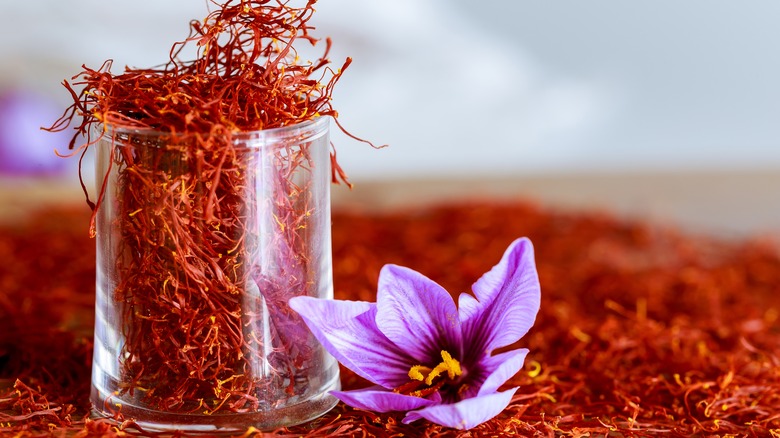Understanding The Different Types And Grades Of Saffron
Even if you know nothing else about saffron, you're probably aware that it's the most expensive spice in the world. Costing as much as $65 per gram, its price by weight is roughly the same as gold, and this extraordinary expense has done good and bad things for saffron's reputation. Most of what has been written about the spice focuses almost exclusively on its price, the cost overshadowing its entire identity. Perhaps this has something to do with the fact that describing the flavor of saffron is a near-impossible task. There is nothing else on Earth to accurately compare it to. Saffron tastes like saffron — that's it. But the most significant and underlooked consequence of focusing on saffron's price is that we end up speaking about it in very broad terms, ignoring the fact that there are multiple types of saffron with particularly nuanced differences.
To understand these differences, we first need to clarify exactly what saffron is, and where it comes from. The spice is typically sold in the form of thin threads. These threads are the stigmas of the saffron crocus, a purple flower with the scientific name Crocus sativus. Each saffron crocus only produces three stigmas, so you can see why it is considered so rare and valuable. All saffron is derived from this one type of flower, but that doesn't mean all saffron is created equal. Each stigma comprises a range of saffron varieties, and we're going to break them all down right now.
Types of saffron
If you look at the whole stigma of a saffron crocus, you will see a distinct color gradient. The base of the stigma is yellow, and as you travel upwards, the hue darkens, first changing to orange, then to a deep crimson at the tip. In Iran, which produces roughly 90% of the world's saffron, the stigmas are divided into four different types of saffron, outwardly characterized by their colors.
Pushal (also spelled 'poshal') is the cheapest variety of saffron, comprising the yellow and orange portions of the stigma. This is the stuff you're most likely to find in grocery stores, although it has the least intense color, flavor, and aroma. Sargol is saffron that comes from the very tip of the stigma. It has a strong aroma, but includes some small crumbs, and because it is so fragile, the threads tend to break. Sargol is often used to make cheaper powdered saffron. Negin, which means 'jewel' in Farsi, comprises the strand of the stigma that extends from the pushal to just below the sargol. The red portion has an intense flavor and aroma, but because you also pay for some of the less potent orange and yellow segments, the overall value of negin is lower than the final, and most expensive, type of saffron. Enter Super Negin, which consists of stigmas that have been precisely trimmed to only include the most potent red portion. It is the most expensive and rare variety, highly prized by chefs.
Saffron grades
Considering its monetary value, it should come as no surprise that saffron is a frequent subject of food fraud. This has been a problem for centuries. In fact, in the 1400s, saffron fraud was such a widespread issue that authorities in Nuremberg established the Safranschou code, which made saffron adulteration punishable by fines, imprisonment, and even execution. Saffron fraud takes many forms. Highly valued types like negin may be combined with less potent varieties or even mixed with colored threads from different plants. Another common method of adulteration is to not fully dry the saffron threads. Leaving more moisture increases the overall weight, and therefore the cost. In order to combat saffron fraud, the International Organization for Standardization (ISO) has established a grading system for determining quality.
Saffron quality is determined by the presence of three chemicals: crocin (determining color), picrocrocin (determining taste), and safranal (determining aroma). Laboratory tests measure crocin, which determines the amount of picrocrocin and safranal, and assign a grade of I, II, III, or IV. Negin and super negin are grade I, the highest quality. Sargol is grade II, and pushal is grade III. Grade IV is reserved for bunch saffron (also known as Dasteh, Dokhtar Pich, or Khooshe) which is the entire saffron stigma comprising negin, sargol, and pushal. It's known as bunch saffron because it is typically sold in bulk bundles, and although it includes the best parts of the stigma, it is considered to have the lowest overall value.


